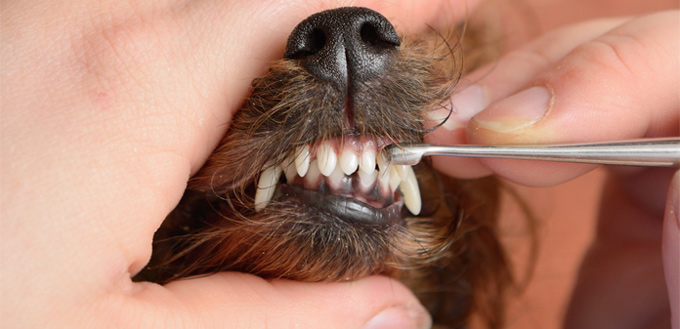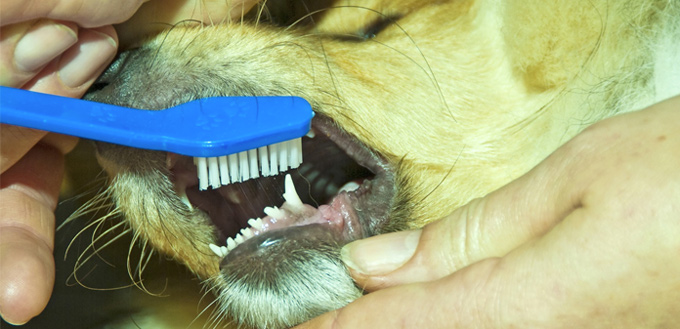You wouldn’t go a week without brushing your own teeth, would you? So why should your dog’s teeth be any different? Brushing your dog’s teeth on a regular basis is important in terms of keep their gums and teeth healthy while also fighting gum disease. Did you know that four out of five dogs over the age of three-years-old experience some form of periodontal disease? This is often caused by the build-up of plaque. A good dental routine is a must to prevent this from happening. Read on to discover what you will need to brush your dog’s teeth as well as the steps you should take.

What Will You Need?
- The most important ingredient: a little patience.
- Pet toothpaste (you should never use human toothpaste).
- A toothbrush: choose a toothbrush with medium bristles and make sure it is the right size. For miniature dogs, a small special pet toothbrush is required. For a small dog, a child’s size brush is advised, and for medium and large dogs, and adult size toothbrush is required.
You May Also Like: Dog Toothbrushes
Some Helpful Tips When Brushing Your Dog’s Teeth:
- Give your dog lots of praise and make sure you reward any good behaviour.
- Brush at least once a day for the best results. You may need to gradually build up to this in the beginning.
- Remember, every dog is different, and not all dogs are going to enjoy getting their teeth brushed. You will need to have patience and go at a pace that suits your dog.
- Pick a time that suits your daily routine – the process is not always going to be straightforward.
- Keep each session short. You can always split up the process into various sessions throughout the day. Don’t let any session last longer than a few minutes.
Brushing Your Dog’s Teeth: a Step-by-step Guide
- Introduce your dog to the toothpaste: Before you start brushing your dog’s teeth, you need to introduce them to the toothpaste. Simply put a small amount on the tip of your finger and allow your dog to lick it off. It should be a pleasant taste, and your dog should want to eat the toothpaste.
- Get your dog used to having something in his mouth: The next step is to get your dog familiar with the sensation of having something in their mouth. Again, put a little bit of toothpaste on the tip of your finger. But this time, gently hold your dog’s muzzle with your other hand to keep the mouth mainly closed. You should then place your finger underneath your dog’s top lip on the side of the face. Rub your fingertip against the dog’s teeth. Of course, the last thing you want is to get your finger chewed so be careful not to allow your dog’s mouth to open. You should then slide the finger further back inside the cheeks. Needless to say, you know your dog better than anyone else, and so if you think there is a very high chance that you will get bitten, you shouldn’t do this. You may also want to seek some behavioural advice if your dog will not sit still when you hold his muzzle.
- Brush the canine teeth: Now the brushing begins! You should use water to wet the toothbrush and then add some toothpaste to the brush, pushing it down into the bristles. Again, you will need to gently hold his muzzle to keep the mouth closed. If you don’t do this, chances are your dog will simply chew the toothbrush when it is introduced. Next, using the thumb of the hand holding the muzzle or a fingertip, lift the top lip on one side of the mouth. Begin by gently brushing your dog’s canine teeth. These are the longest teeth. You should never begin with their incisor teeth, which are located at the front of the mouth, because this is the most sensitive part of their mouth. Once you have done this, lift the lip on the other side by changing your hold on the muzzle, and then brush the canine teeth on this side.
- Reach the teeth at the back: Once you have brushed your dog’s canine teeth, you should move to the teeth at the back of your dog’s mouth. You will need to slip the brush past the corner of the lips inside the cheeks to reach the molar teeth. If you are struggling to get inside the cheek, try using a smaller brush. Start by brushing the upper teeth, and then allow the mouth to slightly open so you can brush along the gum line of the lower teeth. Throughout the process, it is a good idea to gradually increase the brushing. However, if your dog is reacting more than a little bit, you should stop and come back to the session at a later time.
- Brush all teeth – Hopefully, your dog should be more used to the idea of getting his teeth brushed by now. Finish the process by brushing the back and canine teeth on both sides, as you did before. Make sure you are still holding the mouth closed; yet lift the top lip at the front, so you can finally brush the incisors. You should now be able to brush all of the outsides of your dog’s teeth.
Related Post: Dog Dental Spray

So there you have it: everything you need to know about brushing your dog’s teeth. Hopefully, you now feel more prepared for what can often be a difficult and testing process to begin with. However, with a little bit of patience, your dog will soon get used to getting his teeth brushed, and it won’t become such a challenge. Make sure you follow the tips that have been provided to give your dog the gentlest introduction – get them used to the toothpaste first and never start by cleaning their incisors!
Sources:
- Five Ways To Clean Your Pet’s Teeth, Animal Humane Society
- Veterinary Tips For Pet Dental Care, Cornell University College of Veterinary Medicine






